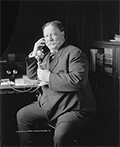William Howard Taft was both President of the United States and Chief Justice of the United States. He was the only person ever to hold both offices. He served one term as President and was Chief Justice for nearly a decade. He was born on Sept. 15, 1857, in Cincinnati. He had five siblings. Their father, Alphonso, was a lawyer and had been President Ulysses S. Grant's Attorney General and Secretary of War; Louisa, his mother, was a college graduate and later contributed to a satirical newspaper. 
Young William grew up in an environment dominated by the law and politics, and he proved to be an adept student and athlete, excelling in wrestling. He graduated from Woodward High School and then Yale College and then Cincinnati Law School; he also covered local courts for the Cincinnati Commercial newspaper. He later won admission to the bar in Ohio. He won appointment as assistant prosecutor for his state's Hamilton County and followed a path of promotion that ended with his being appointed a judge of the Superior Court of Cincinnati. He married Helen Louis Herron in 1886; they had three children: Robert (1889), Helen (1891), and Charles (1897). In 1890, Taft accepted President Benjamin Harrison's nomination to be Solicitor General; Taft was the youngest-ever in the position. Two years later, he won appointment to the U.S. Sixth Circuit Court of Appeals. He served on that panel for eight years; for half that time, he was also a professor of constitutional law and dean at the University of Cincinnati. The United States had claimed possession of the Philippines as a result of the Spanish-American War, in 1898; three years later, Taft became the first civilian to serve as Governor-General of the Pacific island chain. 
President Theodore Roosevelt appointed Taft Secretary of War in 1904. It was in that capacity that Taft ordered an occupation of Cuba and then the establishment of a provisional government, with himself as governor. Roosevelt did not run for re-election in 1908, instead announcing his support for Taft to run for President representing the Republican Party. Taft won the nomination, chose as his running mate New York Congressman James S. Sherman, and defeated William Jennings Bryan in the presidential election. Taft restructured the State Department, introducing the now-familiar geographical divisions. Of particular interest to Taft and Secretary of State Philander Knox was foreign policy in the Caribbean region because of the construction of the Panama Canal and in Central and Southern America, where Taft championed a policy known as Dollar Diplomacy, promoting U.S. investment in countries in that region. Roosevelt had been confident that Taft would carry on the Progressive policies that the Republicans had been championing; Taft had other ideas, aligning himself with the conservative element of the Republican Party and championing the Payne-Aldrich Tariff, which raised taxes on goods coming into the country. At the same time, Taft supported the efforts of activist and educator Booker T. Washington to improve the life and lot of his fellow African-Americans. Taft also vetoed a bill that would have required unskilled laborers to pass a literacy test. Taft had originally wanted to be appointed to the U.S. Supreme Court but had accepted the nomination for President. Once in office, he decided to seek another term and ran for re-election in 1912. Taft had increasingly sided with big business (despite his support for the introduction of a corporate income tax and his advocacy of breaking up trusts) and so had support from much of the powerful members of the Republican Party. After the Republican National Convention nominated Taft for re-election, Roosevelt left to form his own organization, the Progressive Party. (Its nickname was the "Bull Moose Party.") Roosevelt declared himself a candidate for President, as head of this new party. The Democrats lined up behind New Jersey Gov. Woodrow Wilson, and Wilson won a decisive victory, capitalizing on the split Republican vote. Taft then returned to private life, serving as a professor at Yale Law School and, during World War I, as co-chairman of the National War Labor Board. 
In 1921, newly sworn in President Warren G. Harding nominated Taft to be Chief Justice of the United States. Taft won wide respect for his time in that office, writing 250 opinions and serving until 1930. One of his most well-known opinions was writing for the 6–majority in Myers v. United States that Congress had no power to require the President to seek Senatorial approval for firing a presidential appointee. This decision officially invalidated the Tenure of Office Act, the ignoring of which had resulted in the impeachment of President Andrew Johnson in 1868. Taft also joined on the high court six members whom he had appointed as President. Only George Washington and Franklin D. Roosevelt appointed more. He had suffered from poor health for years, in large part because of his obesity, and he retired from the Court on February 3. He died on March 8. Among the firsts achieved by William Howard Taft:
|
|
Social Studies for Kids
copyright 2002–2025
David White




